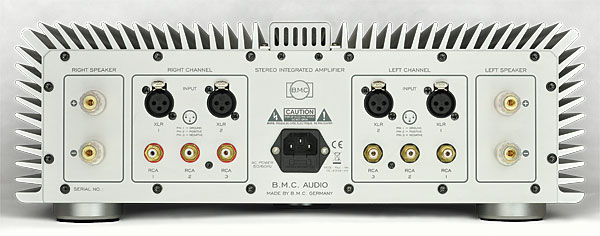| Columns Retired Columns & Blogs |
B.M.C. Audio Amplifier C1 integrated amplifier

B.M.C. Audio GmbH (the initials stand for Balanced Music Concept) designs its high-performance audio products in Germany, where the company was founded in 2009, and has them manufactured in its own wholly owned factory in China. The design team is headed by Carlos Candeias, whose earlier designs included a belt-driven CD transport for C.E.C. and, for Aqvox, a high-performance, current-gain–based, balanced phono preamplifier that's reasonably priced. These have won him a lot of attention, and made him something of a celebrity in certain sectors of the audiophile world.
Candeias has brought to the B.M.C. line the same distinctive engineering and industrial design that distinguished his OEM creations. With its unusually large, centrally mounted, illuminated power meter, you won't confuse the Amplifier C1 with anything but another B.M.C. model.
Candeias's ideas extend beyond engineering. He's developed a new distribution and retailing model in which retailers needn't buy and warehouse expensive stock. Consumers instead purchase directly from the distributor, who returns a percentage to the dealer who brokered the purchase. This arrangement also avoids, among other brand-destabilizing retailing foibles, price-dropping selloffs as older products are replaced by newer ones.
More than a pretty faceplate
Though the fully balanced Amplifier C1 ($7990) is claimed to output 175Wpc into 8 ohms or an impressive 330W into 4 ohms, and has two pairs of balanced inputs, three pairs of single-ended inputs, and a volume control, Carlos Candeias does not call it an integrated amplifier. He prefers "a power amplifier with variable amplification and input choice." His reasons for this will become apparent in my description of the Amp C1's circuit design.
The power supply is generously built, as you might expect for a design that's claimed to almost double its output with a halving of load. At a time when some manufacturers are moving toward lightweight, energy-efficient, switch-mode power supplies, Candeias's 88-lb Amp C1 makes use of the largest toroidal transformer I've ever seen in an integrated amplifier—or whatever you want to call it. I saw this transformer only because the Amp C1 was DOA. Candeias paid a visit a few days later, removed the bottom plate, and found that UPS had literally drop-shipped the unit, shaking loose one of the clip-on connectors.
The Amp C1 is physically impressive. A large porthole that contains the two power meters dominates the faceplate, and also displays the selected input and indicates the volume control setting in 1dB increments, from 00 to 66. The rest of the design adds to the C1's visual appeal: an unusual wraparound heatsink, a central vent-like channel, and an aluminum faceplate with a satiny finish. There's a large Power knob to the meter's left; to its right, a matching Volume knob. A small button between the meter and Power knob controls the illumination level, and a matching one between the meter and the Volume knob toggles through the inputs—which can also be selected via the multi-component remote control of machined aluminum. Unfortunately, there's no direct selection of inputs.

The rear panel is neatly and symmetrical laid out: single-ended input 1's left and right jacks are farthest apart and input 3's jacks are closest together, to either side of the central IEC AC inlet, with pairs of binding posts at either end. Two fans set into the bottom plate send air through the interior. Though they probably did turn on at some point, I never heard the fans operating.
Everything about the B.M.C. Amplifier C1, from its looks to its build quality to how it operates, has been designed to produce a substantial, even luxurious experience at a price that's (dare I say it?) reasonable, considering its innovative circuitry and high power output.
The Unique Circuit
When we met following his visit, at the 2012 Consumer Electronics Show in January, Carlos Candeias told me that the Amplifier C1's circuit is neither class-A nor class-B; instead, he calls it Load Effect Free (LEF). He doesn't use energy-wasting class-A operation to eliminate crossover distortion and have transistors operate within a more or less linear range, because such designs still usually require some global feedback to further reduce distortion. If the distortion never happens in the first place, due to the choice of transistor operating characteristic, it doesn't need to be corrected.
Candeias explained two weaknesses of transistors: variations in voltage and variations in current. Then, rather than explain his system's technical innovations in engineering terms, he compared it with a painter standing before a large canvas, who would be able to paint "more beautifully" directly in front of him, and less so as he was forced to stretch above and below that area. Compound the painter's problem, he said, by placing around his arm two large rubber bands, one of which affects upward-going motions, the other lower-going motions. When he tries to extend his reach up or down, he'll feel how nonlinear his muscle movements are, and he won't be able to paint as beautifully. But as long as his arm remains in the middle of his range of motion, the bands won't affect his painting. Having someone telling you to "Go down! Go up! You're painting ugly!" is analogous to applying global feedback.
To avoid needing such feedback, Candeias explained, "we built a platform below the painter's feet"—in technical terms, a "floating cascode." When the painter moves his arm up or down, the floating cascode accordingly shifts his entire body up or down. So the distortion caused by the restrictions imposed by the rubber bands (voltage, in Candeias's analogy) moves from the painter's hand down to the floating-cascode platform, which is not connected to the speaker—in terms of affecting the sound, it's rendered irrelevant.
But that, Candeias said, is the easy part. The hard part is applying the power required to stretch the rubber band. Extending the analogy, he said that the painter has two friends clamping the two rubber bands, and they're watching the painter's muscles for changes in the amount of power he needs to move his arm. When the amount of power needed changes, the current needed to move the arm without restriction is supplied from a separate source. This allows the Amplifier C1 to deliver the required voltage to the speaker completely independent of the current, and to deliver it from separate sources.
- Log in or register to post comments




































